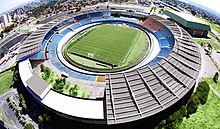Goiás
Goiás (Brazilian Portuguese: [ɡojˈjas] (![]()
State of Goiás Estado de Goiás | |
|---|---|
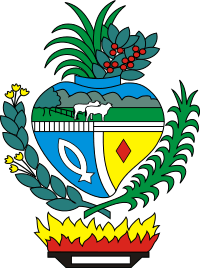 Coat of arms | |
| Anthem: Hino de Goiás | |
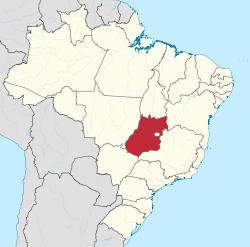 Location of State of Goiás in Brazil | |
| Coordinates: 15°56′S 50°8′W | |
| Country | |
| Capital and largest city | Goiânia |
| Government | |
| • Governor | Ronaldo Caiado (DEM) |
| • Vice Governor | Lincoln Tejota (PROS) |
| • Senators | Jorge Kajuru (PSB) Luiz do Carmo (MDB) Vanderlan Cardoso (PP) |
| Area | |
| • Total | 340,086 km2 (131,308 sq mi) |
| Area rank | 7th |
| Population (2010)[1] | |
| • Total | 6,003,788 |
| • Estimate (2019) | 7,018,354 |
| • Rank | 12th |
| • Density | 18/km2 (46/sq mi) |
| • Density rank | 17th |
| Demonym(s) | Goiano |
| GDP | |
| • Year | 2006 estimate |
| • Total | R$186,130,000,000 (9th) |
| • Per capita | R$26,265,00 (12th) |
| HDI | |
| • Year | 2017 |
| • Category | 0.769[2] – high (10th) |
| Time zone | UTC-3 (BRT) |
| Postal Code | 73700-000 to 76790-000 |
| ISO 3166 code | BR-GO |
| Website | goias.gov.br |
The most populous state of its region, Goiás is characterized by a landscape of chapadões (plateaus). In the height of the drought season, from June to September, the lack of rain makes the level of the Araguaia River go down and exposes almost 2 kilometres (1.2 mi) of beaches, making it the main attraction of the State. At the Emas National Park in the municipality of Mineiros, it is possible to observe the typical fauna and flora from the region. At the Chapada dos Veadeiros the attractions are the canyons, valleys, rapids and waterfalls. Other attractions are the historical city of Goiás (or Old Goiás), 132 km (82 mi) from Goiânia, established in the beginning of 18th Century, and Caldas Novas, with its hot water wells attracting more than one million tourists per year. In Brazil's geoeconomic division, Goiás belongs to the Centro-Sul (Center-South), being the northernmost state of the southern portion of Brazil.
Geography
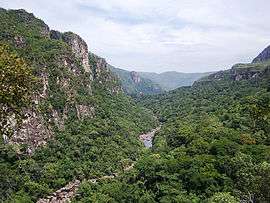
Located in the east of the Center-West region, and adjacent to Brazil's Southeastern region, Goiás lies on the southern portion of the Brazilian Highlands, which are located in the center of the country. It occupies a large plateau, the vast almost level surface of which stands between 750 and 900 m above sea level and forms the divide between three of Brazil's largest river systems: to the south. Goiás is drained by the Paranaíba river, a tributary of the Paraná River; to the east it is drained by tributaries of the São Francisco River; and northward the state is drained by the Araguaia River and the Tocantins River and their tributaries. Other major rivers in the state are the Meia Ponte, Aporé, São Marcos, Corumbá River, Claro, Maranhão, Paranã and Preto. None of these rivers is navigable except for short distances by small craft.
The state's highest point is Pouso Alto, at 1,676 metres (5,499 ft) above sea level, in the Chapada dos Veadeiros.
Goiás is covered with a woodland savanna known in Brazil as campo cerrado, although there are still tropical forests along the rivers. This cerrado has been seriously diminished in recent years due to cattle raising and soybean farming with great loss of animal life and forest cover. The climate of the plateau is tropical. Average monthly temperatures vary from 26 °C (79 °F) in the warmest month to 22 °C (72 °F) in the coldest. The year is divided into a rainy season (October–March) and a dry season (April–September). Average annual rainfall is about 1,700 millimetres (67 in), but this varies due to elevation and microclimate. Some parts of the state, however, have small remnants of tropical Atlantic forest, that mostly appears around rivers and valleys.
The Great Central West Region, consisting of the states of Goiás, Mato Grosso, Mato Grosso do Sul, and the Federal District, is among the fastest-growing regions of Brazil. The population of Goiás state tripled in size in the period from 1950 to 1980 and is still growing very quickly. However, outside the Federal District and the Goiânia metropolitan region (with a population of over a million) most of Goiás is very thinly populated. The chief concentration of settlement is in the southeast, in the area of Goiânia (Goiânia and Aparecida de Goiânia), across the border from Minas Gerais (Catalão, Rio Verde, Jataí, and Caldas Novas), and around the Federal District (Formosa, Planaltina de Goiás, and Luziânia).
History
- See also: History of Goiás
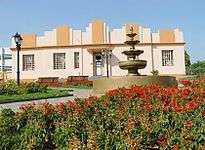

The first European exploration of this interior part of Brazil was carried out by expeditions from São Paulo in the 17th century. Gold was discovered in the gravel of a tributary of the Araguaia River by the bandeirante Bartolomeu Bueno da Silva (the Anhanguera) in 1682. The settlement he founded there, called Santa Anna, became the colonial town of Goiás Velho, the former state capital. In 1744 the large inland area, much of it still unexplored by Europeans, was made a Captaincy General, and in 1822 it became a province of the empire of Brazil. It became a state in 1889. The Brazilian constitution of 1891 specified that the nation's capital should be moved to the Brazilian Highlands (Planalto Central), and in 1956 Goiás was selected as the site for the federal district and capital national, Brasília. The seat of the federal government was officially moved to Brasília in 1960.
Goiânia, the largest city and capital was planned in 1933 to replace the old, inaccessible former state capital of Goiás, 110 kilometres (68 mi) northwest. In 1937 the state government moved there, and in 1942 the official inauguration was held. Goiânia is now one of the fastest growing cities in Brazil and one of the most livable cities in the country. It stands out as both an industrial center (along with the neighboring towns of Anápolis and Aparecida de Goiânia) and as a cultural center for country culture and music, known as Sertanejo.
Due to the relatively large territory of the state, which was over 600,000 square kilometres (230,000 sq mi), communications were obviously very difficult. The northern part of the state began to feel abandoned by the southern government and began a movement for separation. Local political leaders, many of whom were large landowners and were eager to gain important positions such as governor or senator and financial gain with the construction of a new capital, also encouraged the movement. In 1988 the northern half of Goiás became a separate state called Tocantins.
Demographics
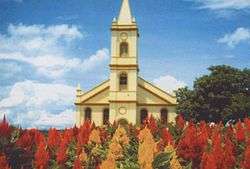
According to the IBGE of 2010, there were 6,004,045 people residing in the state. The population density was 16.9 inh./km2.
Urbanization: 88.6% (2006); Population growth: 2.5% (1991–2000); Houses: 1,749,000 (2006).[3]
The last PNAD (National Research for Sample of Domiciles) census revealed the following numbers: 2,076,000 Pardo (Multiracial) people (49.41%), 3,433,000 White people (51.45%), 329,000 Black people (5.60%), 16,000 Asian people (0.26%), 15,000 Amerindian people (0.25%).[4]
Ethnic groups found in Goiás include: Italians, Amerindians, Portuguese, Africans, Germans, Arabs, Lebanese and Syrian.
According to an autosomal DNA study from 2008, the ancestral composition of Goiás is 83.70% European, 13.30% African and 3.0% Amerindian.[5]
Economy

The service sector is the largest component of GDP at 43.9%, followed by the industrial sector at 35.4%. Agriculture represents 20.7%, of GDP (2004). Goiás exports: soybean 49.2%, meat of cattle 10.5%, gold 9.1%, other meat 7.5%, iron 7.4%, leather 4% (2002).
Share of the Brazilian economy: 2.4% (2005).
Goiás is a leader in the country in crop raising. In 2016, Goiás had the 3rd largest cattle herd in Brazil: 22.6 million head of cattle. [7] The number of pigs in Goiás was approximately 2.0 million head in 2015. The State had the 6th largest Brazilian herd, 5% of the national herd. Among the municipalities in Goiás that stood out, Rio Verde had the 3rd largest national population. In 2016, Goiás was the 4th largest milk producer, accounting for 10.1% of the country's milk production. The number of chickens in the State was 64.2 million head in 2015. The production of chicken eggs this year was 188 million dozens. Goiás was the 9th largest producer of eggs, 5% of national production.[8]
Agriculture as a total represented 21% of the GDP of the state. The state of Goiás stands out in the production of sugarcane, corn, soy, sorghum, beans, sunflower, tomato, garlic, in addition to also producing cotton, rice, coffee and wheat. In 2019, Goiás was the Brazilian state with the 4th highest grain production, 10% of the national production. [9] Goiás is the 2nd largest producer of sugarcane in the country, 11.3% of national production, with 75.7 million tons harvested in the 2019/20 harvest. In the same year, it was the 4th largest producer of soy, with 12.46 million tons. It has the national leadership in the production of sorghum: it produced 44% of the Brazilian crop production in the 2019/2020 cycle, with a harvest of 1.09 million tons.[10] In 2017, it was the 4th largest producer of maize in the country. The state is also the Brazilian leader in tomato production: in 2019 it produced over 1.2 million tons, a third of the country's total production. [11]In 2019, Goiás became the leader of the Brazilian production of garlic.[12][13] Goiás was the 4th largest producer of beans in Brazil in the 2017/18 harvest, with 374 thousand tons, and has about 10% of the country's production.[14] The state is also in 3rd place in the national production of cotton, however, most of the national production is from Mato Grosso and Bahia - Goiás has only 2.3% of participation.[15][16] In sunflower, in 2020 Goiás was the 2nd largest national producer, with 41.8%, losing only from Mato Grosso. In rice, Goiás is the 8th largest producer in Brazil, with 1% of national production.[17]
Minerals are also important with the state being a major producer of nickel, copper, gold, niobium and aluminum (bauxite). Goiás had 4.58% of the national mineral participation (3rd place in the country) in 2017. At nickel, Goiás and Pará are the only two producers in the country, Goiás being the 1st in production, having obtained 154 thousand tons at a value of R$ 1.4 billion. In copper, it was the 2nd largest producer in the country, with 242 thousand tons, at a value of R$ 1.4 billion. In gold, it was the 4th largest producer in the country, with 10.2 tons, at a value of R$ 823 million. In niobium (in the form of pyrochlorine), it was the 2nd largest producer in the country, with 27 thousand tons, at a value of R$ 312 million. In aluminum (bauxite), it was the 3rd largest producer in the country, with 766 thousand tons, at a value of R$ 51 million. [18][19]
In gemstones, Goiás is one of the emerald producing states in Brazil. Campos Verdes is considered the "Capital of the Emeralds". The state also has known production of tourmaline (Brazil is one of the biggest productors of this gem), and sapphire (in a scarce mode).[20][21][22][23]
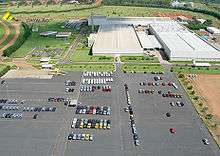
The strongest growing area in the state has been in industry and commerce. Goiás had in 2017 an industrial GDP of R$ 37.1 billion, equivalent to 3.1% of the national industry. It employs 302,952 workers in the industry. The main industrial sectors are: Construction (25.6%), Food (25.2%), Industrial Public Utility Services, such as Electricity and Water (17.2%), Petroleum Products and Biofuels (7.4%) and Chemicals (3.7%). These 5 sectors concentrate 79.1% of the state's industry. [24]
Goiânia and Aparecida de Goiânia have become centers of food-processing industries, Anápolis of pharmaceutical factories. Rio Verde, in the southwest, is one of the fastest growing small cities with many new industries locating in the area and Catalão is a metal-mechanical and chemical center.
In Brazil, the automotive sector represents close to 22% of industrial GDP. Goiás has Mitsubishi, Suzuki and Hyundai factories. [25][26]
Economic indicators
- Agriculture (in tons): sugarcane (9.251.798), soybeans (3.420.653), corn (3.414.601), tomato (759.009), rice (352.135), cotton (278.363), manioc (255.639), beans (200.977)--(1999).
- Livestock (in head): fowl (80.000.000 est.), cattle (18.000.000 est.), pigs (1.000.000 est.) --(1999).
- Minerals: titanium-ilmenite (1.624 t), nickel (52.302 t), manganese (23.242 t), cobalt (484 t), iron (199 brute tons), niobium-pirocloride (54.953 t), gold (4.512.882 grams), silver (211.917)--(1998).
- Industry: food, metallurgy, extraction of non-metallic minerals.
Statistics
- Vehicles: 1,610,972 (March/2007);
- Mobile phones: 3.6 million (April/2007); Telephones: 1.3 million (April/2007)
- Cities: 246 (2007).[27]
Education
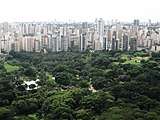
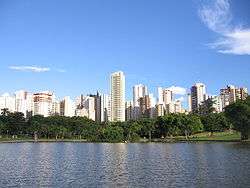

Portuguese is the official national language, and thus the primary language taught in schools. But English and Spanish are part of the official high school curriculum.
Educational institutions
- Universidade Federal de Goiás (UFG);
- Universidade Federal de Jataí (UFJ);
- Pontifícia Universidade Católica de Goiás (PUC GOIÁS);
- Instituto Federal de Educação, Ciência e Tecnologia de Goiás (IFG);
- Instituto Federal de Educação, Ciência e Tecnologia Goiano (IFGoiano);
- Universidade Estadual de Goiás (UEG);
- Universidade Paulista (UNIP Flamboyant);
- Universidade de Rio Verde;
- and many others.
Infrastructure
National airport
Modernization work will soon get under way at Santa Genoveva Airport in the northeast side of Goiânia. With nominal yearly capacity of 600,000 passengers, in 2004 it received 950,000. With its new terminal, it will be able to handle up to 2 million users a year.
Main sights

- Chapada dos Veadeiros
It is an ecological national park famous for the diversity of its landscape and the richness of its fauna and flora.
- City of Goiás
An internationally famous World Heritage Site, the city is notable for its historical importance and colonial architecture.
- Parque Nacional das Emas
The Emas National Park is another World Heritage Site in Goiás.
- Pirenópolis
Pirenópolis is a city in the interior of the State of Goiás, known for its preserved colonial homes and steep stone streets.
Cities
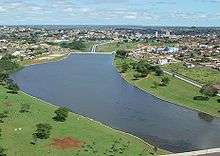
The 15 most populous cities as estimated in 2017 by IGBE:
- Goiânia (1.466.105)
- Aparecida de Goiânia (542.090)
- Anápolis (375.142)
- Rio Verde (217.048)
- Luziânia (199.615)
- Águas Lindas de Goiás (195.810)
- Valparaíso de Goiás (159.500)
- Trindade (121.266)
- Formosa (115.789)
- Novo Gama (110.096)
- Senador Canedo (105.459)
- Itumbiara (102.513)
- Catalão (102.393)
- Jataí (98 128)
- Santo Antônio do Descoberto (90 525)
See City population of Goiás for table showing population from 1991 to 2005 in the 37 largest cities.
- Cities with tourist interest
| Name | Population |
|---|---|
| Caldas Novas | 65,637 |
| Cristalina | 51,133 |
| Ipameri | 22,600 |
| Pirenópolis | 21,241 |
| Goiás | 14,173 |
| Paraúna | 10,900 |
| Corumbá de Goiás | 9,915 |
| Aruanã | 5,212 |
Sport
Goiás Esporte Clube was founded in 1943 and is a regular member of the top two divisions of Brazilian football.
Flag
The green bars in the flag symbolize the spring and the yellow bars gold. The blue rectangle in the topleft corner symbolizes the sky, with the five stars forming the constellation of the Southern Cross. The flag was adopted on 30 July 1919. It is a toned down version of the original Republican flag of Brazil, in itself not original.
Notable people
- Amado Batista singer
- Arthur, footballer
- Carolina Ferraz, actress
- Cora Coralina, poet
- Henrique Meirelles, president of Banco Central do Brasil
- Ingrid Guimarães, actress
- Leandro e Leonardo, singers
- Léo Jaime, singer and songwriter
- Marconi Perillo, former governor
- Marcos Hummel, Rede Record presenter
- Nana Gouvêa, adult model
- Pedro Ludovico political
- Ronaldo Caiado, governor
- Siron Franco, Painter
- Túlio Maravilha, former soccer player
- Wanessa, singer
- Zezé Di Camargo & Luciano, singers
- Paulo Nunes, former soccer player
- Dante Amaral, Brazilian national volleyball team
- Mark James Aitchison, DJ
See also
References
- "Radar IDHM: evolução do IDHM e de seus índices componentes no período de 2012 a 2017" (PDF) (in Portuguese). PNUD Brasil. Retrieved 18 April 2019.
- Source: PNAD.
- Tabela 262: População residente, por cor ou raça, situação e sexo (PDF) (in Portuguese). Goiás, Brazil: IBGE. 2008. ISBN 978-85-240-3919-5. Retrieved 18 January 2010.
- "Archived copy" (PDF). Archived from the original on 6 July 2011. Retrieved 2012-10-29.CS1 maint: archived copy as title (link)
- "Estimativas da população residente nos municípios brasileiros com data de referência em 1º de julho de 2011" [Estimates of the Resident Population of Brazilian Municipalities as of July 1, 2011] (in Portuguese). Brazilian Institute of Geography and Statistics. 30 August 2011. Archived from the original (PDF) on 31 August 2011. Retrieved 31 August 2011.
- Rebanho bovino goiano atinge recorde histórico
- Rebanho goiano alcança recorde
- IBGE prevê safra recorde de grãos em 2020
- Goiás lidera produção nacional de sorgo, segundo o IBGE
- Safra de tomate deve vir 12% menor este ano em Goiás
- Alho em Goiás
- [REVISTA CAMPO E NEGÓCIO Alho brasileiro sofre concorrência desleal]
- Feijão - Análise da Conjuntura Agropecuária
- Qualidade do algodão de MT é destaque em congresso nacional
- MT segue como líder isolado na produção de algodão e safra sobe para 65% em 2017/18
- Goiás passa a ser o terceiro maior produtor de grãos do Brasil
- Anuário Mineral Brasileiro 2018
- Goiás lidera produção de níquel
- Rio e Bahia se unem para produzir joias e bijuterias com esmeraldas
- Algumas Gemas Clássicas
- Mineração de Esmeraldas
- Brasil passa a Colômbia nas esmeraldas
- Goiás Industry Profile
- Setor Automotivo
- O novo mapa das montadoras
- Source: IBGE.
External links
- (in Portuguese) Government of Goiás website
- (in Portuguese) Legislative Assembly of Goiás website
- (in Portuguese) Court of Justice of Goiás website


